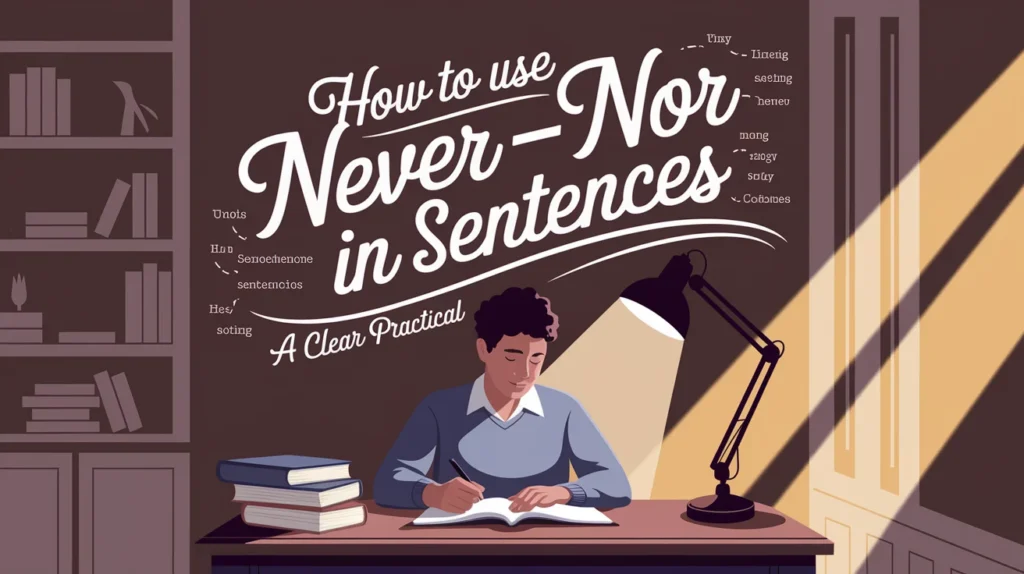Understanding the correct use of “never + nor” in sentences can be a bit tricky, but it’s essential for mastering English grammar. While many people use these words interchangeably, understanding their proper structure is key to sounding more fluent and polished. This guide will walk you through the ins and outs of this grammatical combination, offering practical tips, clear examples, and common mistakes to avoid. Whether you’re writing a formal report or having a casual conversation, mastering “never + nor” will give you more flexibility and confidence in your English.
In this article, we will cover:
- The exact meaning of “never” and “nor”
- How to use them together grammatically
- Common mistakes to avoid
- Real-life examples from literature, journalism, and daily conversation
- And a practice section to help reinforce what you learn
What Does “Never + Nor” Actually Mean?
Understanding “Never”
The word “never” is a strong negative adverb, which means “at no time” or “not ever.” It expresses a complete negation of something happening in the past, present, or future. For instance:
- “I have never been to Paris.”
- “She never calls me back.”
In both cases, “never” completely denies the possibility of an action occurring.
What About “Nor”?
The word “nor” is a coordinating conjunction that is often used to introduce a second negative idea or item in a sentence. It is commonly paired with words like “neither” or “not” to add balance and contrast. For example:
- “She doesn’t like tea, nor does she enjoy coffee.”
- “Neither the cat nor the dog is allowed on the furniture.”
When used in a sentence, “nor” continues the negative idea set up by a previous clause. It’s important to note that “nor” should not be used alone without a preceding negative word like “never.”
Combined Meaning of “Never + Nor”
When you combine “never” with “nor”, you’re essentially stacking two negatives, negating multiple ideas or actions at once. For example:
- “He never called, nor did he apologize.”
- “She never visited, nor did she send a card.”
In both cases, “never” sets up the negative idea, and “nor” adds a further negation. This construction emphasizes the complete absence of the actions mentioned.
Grammatical Structure Behind “Never + Nor”
Parallel Structure
One of the most important aspects of using “never + nor” correctly is ensuring parallel structure. Parallel structure means that both clauses after “never” and “nor” must be grammatically equal. This applies to verbs, subjects, and tenses. For example:
- Correct: “She never calls, nor does she reply.”
- Incorrect: “She never calls, nor she replies.”
Notice that in the correct example, both parts of the sentence follow the same structure: subject + verb. In the incorrect example, the second clause breaks this structure, which makes it sound awkward.
Inversion with “Nor”
One common challenge with “never + nor” is remembering to invert the subject and verb after “nor.” In English, after negative words like “never,” “nor,” or “neither,” you need to invert the subject and the auxiliary verb to maintain proper word order. This is a standard rule of inversion in negative constructions.
For example:
- Correct: “He never smiled, nor did he apologize.”
- Incorrect: “He never smiled, nor he did apologize.”
When you use “nor,” make sure that the verb comes before the subject in the second clause.
When Should You Use “Never + Nor”?
Formal vs. Informal Tone
While “never + nor” is grammatically correct, it tends to sound more formal or literary. It’s commonly used in written English or in more formal speech. In informal conversations, people often prefer using simpler structures like “not” and “and”.
For example:
- Formal: “He never spoke, nor did he take action.”
- Informal: “He never spoke, and he didn’t take action.”
Using “never + nor” adds a sense of emphasis and makes the statement sound more deliberate and impactful.
Writing vs. Speaking
In writing, especially formal writing, “never + nor” is often preferred to convey a clear, emphatic negation. It creates a certain rhythm in the sentence that can make it more striking and memorable. In speech, though, it may sound overly formal, so it’s better suited for contexts where clarity or stylistic emphasis is needed.
Common Mistakes to Avoid
Mistake 1: Using “And” Instead of “Nor”
One of the most common mistakes people make is replacing “nor” with “and”. Since both “never” and “nor” are negative, “and” is not an appropriate connector between them.
- Incorrect: “She never calls and she never visits.”
- Correct: “She never calls, nor does she visit.”
Mistake 2: Forgetting to Invert the Verb After “Nor”
After “nor,” you need to invert the verb and subject. If you don’t do this, the sentence will sound unnatural and ungrammatical.
- Incorrect: “He never called, nor he apologized.”
- Correct: “He never called, nor did he apologize.”
Mistake 3: Using “Nor” Without a Preceding Negative
Another mistake is using “nor” without first having a negative word like “never” or “neither”. “Nor” doesn’t introduce a negation by itself; it always follows a negative phrase.
- Incorrect: “He called, nor did he leave a message.”
- Correct: “He never called, nor did he leave a message.”
Real-Life Examples in Context
Literature
Authors often use “never + nor” in literature to convey a deep sense of negation or rejection. For instance, in classic novels or poetry, the structure adds a dramatic flair that emphasizes absolute denial.
- Example: “The truth never came to light, nor did anyone seek it.”
Journalism
Journalistic writing tends to follow a more straightforward style, but “never + nor” can still be seen in headlines or editorials when the writer wants to add emphasis to a negative outcome.
- Example: “He never admitted guilt, nor did he apologize to the victim.”
Everyday Use
In daily conversation or casual writing, “never + nor” might sound a little formal but is still used effectively to express rejection or contrast.
- Example: “She never showed up for the meeting, nor did she inform anyone.”
Comparison: “Never + Nor” vs. Similar Structures
“Neither… Nor…”
While “never + nor” expresses a negation of two actions or events, “neither… nor…” is often used for similar purposes but with a slightly different tone. “Neither” typically refers to a choice between two things that are both rejected or negated.
- Example: “He is neither tall nor strong.”
“Not Only…but Also…”
The “not only…but also…” construction, while also used to join ideas, expresses addition rather than negation. It’s a positive contrast instead of a double negative.
- Example: “He is not only talented, but also hardworking.”
When to Use Alternatives
Sometimes, simpler phrasing without “never + nor” is preferred to avoid sounding overly formal or complex. Use alternatives like “not” and “and” for a more conversational tone.
Practice Section: Try It Yourself
Let’s see if you can master “never + nor” with a little practice. Try filling in the blanks:
- “She never answered the phone, nor did she return my messages.”
- “They never showed up, nor did they apologize.”
Rewrite these sentences to avoid mistakes:
- “He never plays sports, and he never watches them on TV.”
- “She never visits, nor she writes any letters.”
Summary Table: Quick Rules at a Glance
| Rule | Example | Mistake to Avoid |
| Use “nor” after a negative | Never smiled, nor did he laugh. | Don’t use “and” after “never” |
| Invert subject and verb after “nor” | Nor did she respond. | Not “Nor she responded” |
| Keep parallel tense and form | Never called, nor texted. | Avoid switching tenses mid-thought |
Conclusion:
Understanding and using “never + nor” can add clarity and emphasis to your writing or speech, especially when you need to negate multiple actions in a single sentence.
By following the simple grammatical rules, avoiding common mistakes, and practicing with real examples, you’ll quickly gain confidence in using this structure correctly.
Next time you want to convey absolute negation in your writing or speaking, consider using “never + nor” to make your point in a more elegant, emphatic way.
Frequently Asked Questions (FAQs)
1. Can I use “nor” without “never” or another negative word?
No. “Nor” must follow a negative expression like “never,” “neither,” or “not.” It cannot introduce a negative idea on its own.
✅ Correct: He never showed up, nor did he call.
❌ Incorrect: He showed up, nor did he call.
2. What’s the difference between “never + nor” and “neither + nor”?
Both are used to express negation, but they work differently in sentences:
- “Never + nor” negates two actions or events.
- “Neither + nor” is used to negate two nouns, pronouns, or phrases.
✅ He never answered the phone, nor did he reply to emails.
✅ Neither the manager nor the assistant was available.
3. Do I need to invert the verb after “nor”?
Yes. After “nor,” the sentence structure must be inverted: the auxiliary verb comes before the subject.
✅ Correct: Nor did she explain.
❌ Incorrect: Nor she did explain.
4. Is it okay to say “never and nor” in the same sentence?
No. The correct form is “never… nor,” not “never and nor.” Using “and” creates an illogical double conjunction.
✅ Correct: He never ate breakfast, nor did he drink coffee.
❌ Incorrect: He never ate breakfast and nor drank coffee.
5. Can I use “never + nor” in everyday conversation?
You can, but it sounds more formal or literary. In casual speech, people often use simpler phrases like:
- He didn’t come, and he didn’t call either.
- She didn’t respond or show up.
However, using “never + nor” in writing or formal speech can help you sound more polished and grammatically precise

Mira Olive is a passionate spiritual writer dedicated to exploring the profound meanings behind angel numbers. With a background in numerology and a deep connection to the spiritual realm, Mira crafts insightful articles that guide readers on their journeys of self-discovery and personal growth.



